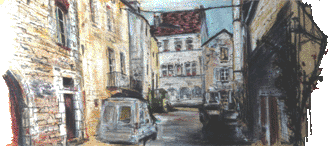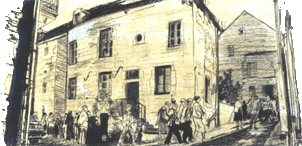|
|
|
|
|
|
|
|
|
|
|
|
|
|
|
|
|
|
|
|
|
|
|
|
|
|
|
|
|
|
|
|
|
|
|
|
|
|
|
|
Page 1 |
|
Page 2 |
|
Page 3 |
|
|
|
|
Page 4
|
|
|
|
 |
|
 |
 |
|
|
|
|
|
|
|
|
|
|
|
|
|
|
|
|
|
|
|
|
|
|
|
|
At the end of the eighteenth century, Flavigny was a hive of activity, with a greater population than ever before or since. Walking through the maze of streets and alleyways, open markets and tiny squares, one might encounter tanners, oil-merchants, millers, potters and tin workers, glass-blowers and weavers, as well as notaries, lawyers, doctors, apothecaries and other bourgeois, not to mention the vintners, farm labourers and members of the clergy.
At the Revolution, all of the monastic buildings were sold as goods of the state; they were bought by individuals and entrepreneurs, some of whom used the ancient buildings as stone quarries. You can see little romanesque pilasters built into the walls of some of the gardens outside of town that were enclosed at this time.
In the nineteenth century, Flavigny was a prosperous wine-making town; it became the administrative centre of the Canton and had its own police department, justice of the peace, tax office. There were frequent markets and fairs in the town. |
|
|
|
|
|
|
|
|
|
|
|
|
|
|
|
|
|
|
|
|
|
|
|
|
|
|
|
|
|
|
|
|
Rue du Centre et la Maison au Donataire ( S.I.) . .......(AD 1991©) .......(AD 1991©)
|
|
|
|
 |
|
|
|
|
|
|
|
|
|
|
|
|
|
|
|
|
|
|
|
|
|
|
|
|
©
|
|
|
|
|
|
|
|
|
|
|
|
|
|
|
|
|
|
|
|
|
|
|
|
 |
|
|
|
|
|
|
|
|
|
|
|
The direct descendants of these communal events are the " Foire de la St Simon ", which I and some other inhabitants of the town reinvented in 1977, and, for the past few years, the weekly market of the " Quatre Saisons " .
In 1848, Father Lacordaire came to town and established his seminary here.
In 1863, the town became the first community in the area to benefit from running water; electicity would quickly follow, powered by a turbine at the Moulin Chantrier in the valley of the Ozerain.
|
|
|
|
|
|
|
|
|
 |
|
|
|
|
|
|
|
|
|
dmj:020718
|
|
|
|
|
|
|
|
|
|
|
|
|
|
|
|
At the end of the century, the population of the town had begun a steady decline; the phylloxera finished off the wine industry and the agriculture of the region turned to the production of grains and dairy products.
|
|
|
|
|
|
|
|
|
|
|
|
|
|
When the railway passed through Les Laumes and up the valley of the Oze instead of that of the Ozerain, the decline of the village accelerated. The two world wars took their inevitable toll on the male population, and on the quality of life itself. After the Liberation, the police station and justice of the peace, symbols of Flavigny’s status as administrative centre, were transferred to Venarey-les-Laumes. Businesses also began to move down from the hill and into the plain.
... But for quite a few years now, there has been movement in the opposite direction. Young people are returning to the town; children are born, businesses reborn, there are new ideas and new activities… |
|
|
|
|
|
|
|
|
|
|
|
|
|
|
|
THE END. . .
. . . to be continued
|
|
|
|
 |
|
|
|

